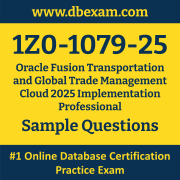01. Which two can be planned into shipments?
(Choose two.)
a) Ship Units
b) Order Releases
c) Order Bases
d) Order Movements
e) Ship Unit Lines
02. How can you group items with similar characteristics in OTM?
a) Use Equipment Class.
b) Use Equipment Group Profile.
c) Use Commodity
d) Use NMFC Class.
03. At which three levels does Match Rules allow the Invoice Matching to occur?
(Choose three.)
a) Shipment location level
b) Order line level
c) Shipment Ship Unit level
d) Shipment Ship Unit line level
e) Shipment level
04. Identify two statements that are true about multi-stop itineraries?
(Choose two.)
a) The "Primary" check box is mandatory on a multi-shop itinerary leg.
b) The Multi-Stop Itinerary cannot be used to plan direct shipments.
c) The Multi-Stop Itinerary option needs to be checked.
d) Multi-Stop Itineraries contain multiple itinerary legs.
05. Select the three correct statements regarding Freight Settlement in OTM.
(Choose three.)
a) Invoices in OTM must be tied to a shipment.
b) Invoice checks may be printed out of OTM.
c) Freight Invoices may be created within OTM or interfaced from an external system.
d) Freight Settlement in OTM may be used to pay invoices to carriers as well as bill customers for freight.
e) Rules for matching, approval, and allocation are the cornerstones of automation in Freight Settlement.
06. What are SmartLinks used for in OTM?
a) to navigate from one Group on the User Menu to another Group, without closing the active window
b) to create linkages for the users IDs from one child domain to its parent domain, or the public domain
c) to access the Actions menu
d) to view related objects
e) to create linkages for the User IDs from one child domain to an equal child domain
07. After creating a report, which step must occur in order to register the report for execution within Oracle Transportation Management?
a) Create a new Data Source pointing to the OTM database.
b) Select the Report System and specify the Report Path.
c) Create a new Data Source pointing to the BI Publisher database.
d) Make a directory "BIPCatalogUtil" under [BI Publisher Home]/
08. In which two situations is redriving used?
(Choose two.)
a) To redrive the shipment if the tracking event location is a specific stop on a shipment
b) To redrive the entire shipment
c) To redrive the shipment from the first stop of the shipment to the location of the tracking event
d) To redrive the shipment from the location of the tracking event to the next stops of the shipment
09. Which are two ways in which Milestones differ from Agents?
(Choose two.)
a) Milestones may be made up of one or more Agents.
b) Agents may be made up of one or more Milestones.
c) Milestones may be both "reactive" (for example, they monitor for a condition to occur) and "proactive" (for example, they can initiate before, at, or a prescribed occurs.)
d) Agents monitor for a condition to occur, whereas Monitors only start and stop based on a time-based schedule.
10. How does one execute the CSVUTIL upload into OTM?
a) Run the import just as you would for a standard CSV file.
b) Select CSVUTIL under Business Process Automation > Data Management > Power Data > CSVUTIL.
c) In the browser URL window, point to "server name"/GC3/html/UTILS, then select CSVUTIL from the dropdown list.
d) Select CSVUTIL under Business Process Automation > Data Management > CSVUTIL.
e) Download CSVUTIL (freeware) from the internet, install it to your PC, and direct it to your OTM database.
 The Oracle Fusion Transportation and Global Trade Management Cloud Implementation Professional (1Z0-1079-25) Sample Question Set is designed to help you prepare for the Oracle Fusion Transportation and Global Trade Management Cloud 2025 Certified Implementation Professional certification exam. To become familiar with the actual Oracle Certification exam environment, we suggest you try our Sample Oracle 1Z0-1079-25 Certification Practice Exam.
The Oracle Fusion Transportation and Global Trade Management Cloud Implementation Professional (1Z0-1079-25) Sample Question Set is designed to help you prepare for the Oracle Fusion Transportation and Global Trade Management Cloud 2025 Certified Implementation Professional certification exam. To become familiar with the actual Oracle Certification exam environment, we suggest you try our Sample Oracle 1Z0-1079-25 Certification Practice Exam.